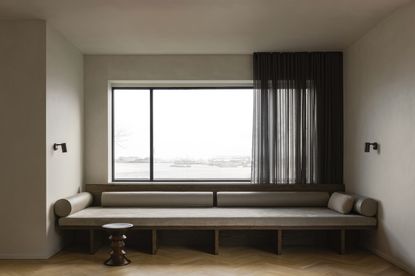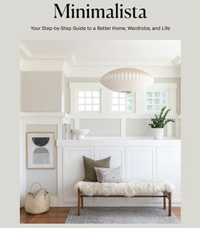What minimalism means and how it is evolving to become the warmest decor trend of 2023
Designers are welcoming a warmer, more organic form of minimalism to help create comfort, connection and belonging

Minimalism has had many forms over time, from its roots in stoicism and ancient Greece, to the fine art movement of the 1960s, to today’s decluttering gurus like Marie Kondo. But each expression of minimalism has had a similar goal: to eliminate excess.
“For centuries, people have chosen minimalism as a form of inner luxury, seeking to escape the complexity of the material world,” says Norm Architects Founding Partner Jonas Bjerre-Poulsen. “From Zen monks in Japan to the Shakers in the US, simplicity has been used to seek a sense of wellbeing.”
When it comes to minimalism in interior design, this quest for simplicity has often manifested as cold-feeling spaces including few objects, sharp edges and cool neutral tones. However, designers today have a more expansive approach, championing a form of minimalism that’s warmer and more organic.
As Jonas Bjerre-Poulsen describes in his book, Soft Minimal: A Sensory Approach to Architecture and Design, his studio aims to “resensualize” the built environment. He explains: “Our approach to minimalism is about eliminating the irrelevant in order to emphasize what is important in life through tactile designs and interiors that invite you to engage with them.”
What minimalism means and how it is evolving
1. Engaging the senses with natural materials

Contrasting modernist trends for concrete, steel grids and engineered glass, we can create more sensual, tactile spaces by incorporating natural materials. Minimalist kitchens, for example, tend to be made with woods and stone. They help us to reconnect with our own place in nature, securing our sense of belonging, identity and safety. Jonas Bjerre-Poulsen explains: “By working with natural forms, materials and colors we can create spaces and objects that engage with our ancient aesthetic preferences—that feel good, look good and that last.”
He continues: “We instinctively enjoy the feel of wood more than that of plastic, and find views of the sky or a lake more pleasing than skyscrapers. We need sunlight to give way to darkness so we can wake, eat, and sleep, whereas artificial light unbalances our system. Deep down we know these natural elements are nourishing, and they therefore evoke safety and wellbeing.”
2. Finding warmth and security

Luca Scardulla, Co-Founder of architecture practice Llabb, also believes minimalism is evolving. “A couple of years ago it was characterized by cold materials and cutting lines," he says. "Nowadays we need warmth and a feeling of security. We need to live in embracing and relaxing spaces, ones that contrast life out there: stressed, noisy and uncertain”.
According to the designer, the pandemic accelerated the evolution of minimalism, and showed us why minimalism is a better way of life. In losing things we’d normally take for granted, from control over our health to being able to see friends and family, many of us found a renewed appreciation for what matters. “The lockdown experience undoubtedly brought to light the need for a 'less is more' philosophy,” says Luca Scardulla.
Our relationships with our homes evolved during this period too, as they became shelters from a world that was newly dangerous. This is a big tenet in current architecture trends. “Our living spaces had to convey the feeling of safety and comfort,” says Luca Scardulla. “And so we saw the style of ‘warm minimalism’ taking hold. This leaves sharp lines and cold materials behind to make way for natural elements, warm color palettes and textile accessories that are selected without abandoning the concept of functionality and order.”
3. Reducing possessions to heighten the quality

One of the main characteristics of minimalism is reduction. But while traditional minimalists may have used reduction as a means to simplify, designers today are using it to intensify experiences or sensations.
“In my opinion, the goal of minimalism is to heighten,” says Paolo Ferrari, Founder of Studio Paolo Ferrari. “Whether it’s heightening the quality of the ritual of bathing, or celebrating the daily ritual of making tea, minimalism brings attention to minutiae and draws us deeper into a given moment.”
This allows the new wave of minimalism to be more decorative than traditional expressions of the trend, where ornaments were all but banished. In fact, the best minimalist houses now have plenty of personality on display. “For us, minimalism can still be expressive or decadent,” says Paolo Ferrari. “In the past, I think minimalism carried the connotation of sparseness, ultra restrained and void of color or contrast. I would say that today, minimalism is more about clarity and an abandonment of excess. It’s a constant balance of restraint and exuberance.”
Minimalism has always been about much more than an interior design trend: it’s a way of life. It’s only natural then, that as the world changes, our needs—and ways to address those needs through design—would change too.

Minimalista: Your Step-by-Step Guide to a Better Home, Wardrobe, and Life, by Shira Gill, Amazon
An inspiring and easy guide to going minimalist, Shira Gill makes the latest design approaches seem doable, even fun.
Be The First To Know
The Livingetc newsletter is your shortcut to the now and the next in home design. Subscribe today to receive a stunning free 200-page book of the best homes from around the world.
Kate Hollowood is a freelance journalist who writes about a range of topics for Marie Claire UK, from current affairs to features on health, careers and relationships. She is a regular contributor to Livingetc, specializing in reporting on American designers and global interiors trends. Based in London, Kate has also written for titles like the i paper, Refinery29, Cosmopolitan and It’s Nice That.
-
 These 12 Best Table Lamps for Your Desk — Perfect Glows for a Creative Home Office
These 12 Best Table Lamps for Your Desk — Perfect Glows for a Creative Home OfficeThe best table lamps for your desk is have a soft, targeted glow. Elevate your WFH set-up with these stylish picks endorsed by Style Editor Brigid Kennedy
By Brigid Kennedy Published
-
 The Nespresso VertuoPlus is 30% Off for President's Day, and it's Kim Kardashian's Coffee Maker of Choice
The Nespresso VertuoPlus is 30% Off for President's Day, and it's Kim Kardashian's Coffee Maker of ChoiceThis sleek and stylish coffee maker was spotted in Kim's home bar, and you can currently save $60 if you buy yours from Amazon
By Lilith Hudson Published

